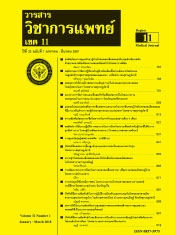Outcomes of intravenous thrombolytic therapy for acute ischemic stroke in sichon hospital
Abstract
Background : Acute ischemic stroke is the most common problem in both Thailand and around the world and the second leading cause of death in the world.Incidence of acute ischemic stroke has increased in 2010 in Thailand. Thrombolysis with the intravenous recombinant tissue plasminogen activator (rt-PA) is now the standard treatment for acute ischemic stroke patients who have onset of stroke less than 4.5 hours. This FDA-approved treatment has been shown to reduce long term disability, reduce mortality rate and complication in acute ischemic stroke patients.Side effects of rt-PA was intracerebral hemorrhage (6%). Sichon hospital has introduced thrombolysis with the intravenous recombinant tissue plasminogen activator (rt-PA) to develop a modern treatment system and standardized treatment .
Objective : To study the outcomes of intravenous thrombolytic therapy in acute ischemic stroke patients at sichon hospital.
Methods : A retrospective review was performed on acute ischemic stroke patients who arrived at sichon hospital within 4.5 hours of symptom onset and entered the stroke fast tract program from 1 January 2012 to 31 December 2016 .Medical records of eligible patients were studied. Baseline characteristics,Initial National Institute Health Stroke Scale (NIHSS) score,Initial systolic and diastolic blood pressures were recorded.The main outcomes were identified about thrombolysis time (door to needle time, onset to needle time, door to CT brain time and door to lab time), the NIHSS score before and after treatment, Barthel index,clinical outcome and complication after therapy.Quanlity indicators for treatment were intravenous thrombolytic therapy rate and stroke fast tract program access rate.
Results : AII 1,473 acute stroke patients presented to emergency room at sichon hospital from 1January 2012 to
31 December 2016. There were 446 acute ischemic stroke patients.There were 171 acute ischemic stroke patients who arrived at the hospital within 4.5 hours from the onset of symtoms and 42 patients were eligible for intravenous rt-PA therapy. The median NIHSS score before thrombolysis was 10.Median initial systolic and diastolic blood pressures before thrombolysis were 153/87 mmHg. Median time to intravenous thrombolysis in 5 years were studied.The median door to needle time was 59 minutes, the median onset to needle time was 120 minutes, the median door to computerized tomography brain time was 20 minutes and the median door to lab time was 45 minutes.The NIHSS score was dramatically improved (78.6%),worsed (11.9%),and stable (9.5%) after thrombolytic therapy.Outcome Barthel ADL index was good (increased score) in 61.9%,poor (decreased score) in 7.1%,stable (same score) in 23.9%.Severe case could not be evaluated Barthel ADL index (7.1%).
Clinical outcome (discharged) was improved (88.1%),worsed (7.1%),stable (2.4%)and died (2.4%).One patient died after thrombolytic therapy in 2014 due to intracerebral hemorrhage. No complication after treatment was
33 patients (78.6%). Complication due to thrombolytic therapy and hospital admission were intracerebral hemorrhage 3 patients (7.1%), brain edema 3 patients (7.1%), pneumonia 3 patients (7.1%),bed sore 1 patient (2.4%) and failing bed 1 patient (2.4%) in 5 years. Quanlity indicators for treatment were intravenous thrombolytic therapy rate (9.42%) and stroke fast tract program access rate (38.34%) in 5 years.
Conclusions : The standard treatment for acute ischemic stroke patients is thrombolysis with the intravenous recombinant tissue plasminogen activator (rt-PA) in whom who have onset of stroke less than 4.5 hours. Stroke fast tract program is the most important. Although the number of patients with acute ischemic stroke receiving
rt-PA in this study was small, thrombolytic therapy can be performed safety and effectively by physicians in the community hospital setting.
References
Feigin VL. Forouzanfar MH, KrishnamurthiR.Global Burden of Disease , Injuries , and Risk Factors Study 2010 (GBD2010) and the GBD stroke Experts Group.Global and regional burden of stroke during 1990-2010 : finding from the Global burden of Disease Study 2010; 383 : 245-254.
Feigin VL, Lawer CM ,Bennett DA,et al.World wide stroke incidence and early case fatality reported in 56 population –based studies : a symptomatic review.Lancet Neurol 2009 ; 8 : 355-369
เกรียงศักดิ์ ลิ้มพัสถาน.โรคหลอดเลือด Cerebrovascular disease.หน่วยประสาทศัลยศาสตร์ คณะแพทยศาสตร์ มหาวิทยาลัยเชียงใหม่ : 2553.
ดิษยา รัตนากร,ชาญพงค์ ตังคณะกุล,สามารถ นิธินันท์,นิจศรี ชาญณรงค์ สุวรรณเวลา,สุชาติ หาญไชยพิบูลย์กุล,ยงชัย นิละนนท์.Current Practical Guide to Stroke Management .สวิชาญการพิมพ์ ; 2554
Hacke W, Less K, Toni D, et al. Acute Sroke Treat.Update 2006 (An educational slide KH) product by infall Kommunikation through an education grant from Boehringer Intelheim Gmbit (Actilyse)2006 ; 50.
อ.พญ.กนกวรรณ วัชระศักดิ์ศิลป์.การพัฒนาระบบการดูแลผู้ป่วยโรคหลอดเลือดสมองแบบครบวงจร (Stroke Net Work) โรงพยาบาลมหาราชนครเชียงใหม่ คณะแพทยศาสตร์มหาวิทยาลัยเชียงใหม่.J Thai Stroke Soc 2015; 14: 23-34.
ศศิวิมล มงคลดี. แบบรายงานการตรวจราชการระดับจังหวัด ปีงบประมาณ 2560. คณะที่ 2 การพัฒนาระบบบริการ (service plan) หัวข้อสาขาโรคหลอดเลือดสมอง จังหวัดน่าน : เขตสุขภาพที่ 1,2560.(อัดสำเนา)
คณะทำงานพัฒนาระบบบริการสุขภาพ สาขาโรคหลอดเลือดสมอง. เขตบริการสุขภาพที่ 8 แนวทางพัฒนาระบบบริการสุขภาพ (service plan).สาขาโรคหลอดเลือดสมอง. 2558.
โรงพยาบาลกาฬสินธุ์. ทีมนำทางคลินิกอายุรกรรม Clinical tracer Highlight : โรคหลอดเลือดสมอง [25-05-2016] : http://203.114.124.101 : 8080.
จุฑาภรณ์ บุญธง. แบบรายงานการตรวจราชการกระทรวงสาธารณสุข ปีงบประมาณ 2560 คณะที่ 2 การพัฒนาระบบบริการ (service plan) หัวข้อสาขาโรคหลอดเลือดสมอง อำเภอแม่ทา จังหวัดลำพูน: เขตสุขภาพที่ 1, 2560 (อัดสำเนา)
ศีระษา แซ่เนี้ยว.อัมพฤกษ์-อัมพาต Hua Hin Fast Track.เพชรบุรี : โรงพยาบาลหัวหิน , 2558. (อัดสำเนา)






